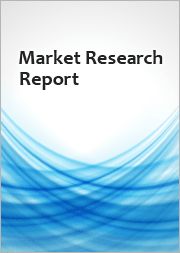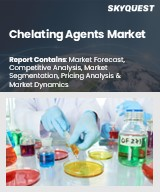
|
시장보고서
상품코드
1752366
세계의 킬레이트제 시장 수요 및 예측 분석(2018-2034년)Global Chelating Agents Market Demand & Forecast Analysis, 2018-2034 |
||||||
킬레이트제는 금속 이온과 상호 작용하여 킬레이트라고 알려진 안정한 고리형 구조를 형성하는 특수 화합물입니다. 이러한 화합물은 제지 및 펄프, 농약, 수처리, 식음료, 세정, 석유 및 가스, 의료, 섬유 등 다양한 산업에서 중요한 역할을 합니다. 에틸렌디아민 테트라 아세트산(EDTA)은 가장 잘 알려진 킬레이트제 중 하나로, 식품 및 음료 산업에서 제품의 안정성을 유지하고 유통기한을 연장하는 포획제로 널리 사용되고 있습니다.
세계 킬레이트제 시장은 유형별로 아미노폴리카르복실산, 하이드록시칼복실산, 유기 포스포네이트, EDTA, 니트릴로삼아세테이트(NTA), 기타로 분류되며, 2024년에는 하이드록시칼복실산이 가장 많이 소비되는 부문으로 부상했습니다. 이는 주로 글루콘산의 나트륨 염인 글루콘산나트륨이 전 세계 킬레이트제 소비의 대부분을 차지했기 때문입니다. 이러한 우위는 이 화합물의 광범위한 사용과 다재다능함을 반영합니다.
킬레이트제 시장의 성장은 최종 사용 산업의 수요와 밀접한 관련이 있습니다. 예를 들어, 펄프 및 제지 산업에서는 표백 공정에서 EDTA와 디에틸렌트리아민 펜타 아세트산이 널리 사용되고 있습니다. 이러한 약제는 펄프의 표백 가능성을 향상시키고, 비용을 절감하며, 제품의 품질을 향상시킬 수 있습니다.
농업에서는 토양의 양분 이용률을 높이고 작물 수확량을 늘리기 위해 이러한 약제를 사용합니다. 식품 및 음료 산업은 방부 및 안정화 작용의 혜택을 누리고 있습니다. 수처리 및 세척 부문은 금속 이온을 관리하고 효율성을 향상시키는 킬레이트제에 크게 의존하고 있습니다.
특히 킬레이트제 생산과 관련된 제조 공정과 원재료에 대한 환경적 고려가 강조되고 있습니다. 지속가능한 관행과 규제 준수의 중요성이 점점 더 커지고 있으며, 기업들은 제품의 품질을 유지하면서 환경에 미치는 영향을 줄이기 위해 적응하고 있습니다.
아시아태평양, 특히 중국과 인도는 급속한 산업 확장과 환경 의식의 증가에 힘입어 고성장 시장으로 부상하고 있습니다. 유럽과 북미는 최종 사용 산업이 성숙하여 안정적인 수요를 유지하고 있습니다.
세계의 킬레이트제 시장에 대해 조사 분석했으며, 시장 역학 및 산업 동향, 각 부문별 수요, 제조업체 프로파일 등의 정보를 전해드립니다.
목차
제1장 소개
제2장 시장 요약
- 시장의 진화
- 수요 개요
- 산업 구조
- 전략상 문제
- 최종 용도 동향
- 성장 예측
제3장 경제와 에너지 전망
- GDP와 인구통계
- 금융 정책과 재정 정책
- 원유 생산과 가격
- 천연가스
- 전기요금
제4장 최종 용도 부문 실적
- 농업
- 건설
- 펄프·제지
- 식품 및 음료
- 화학
- 기타
제5장 킬레이트제 소개와 시장 개요
- 제품 설명
- 등급과 특성
- 원재료
- 제조 공정
- 환경 문제
- 밸류체인
- 용도
제6장 시장 역학과 산업 동향
- 시장 역학
- 성장 촉진요인
- 성장 억제요인
- 기회
- 과제
제7장 세계의 킬레이트제 수요 분석 : 유형별, 용도별(수량과 금액)(2018-2034년)
- 전략상 문제와 COVID-19의 영향
- 수요 분석과 예측(2018-2034년)
- 수요
- 수요 성장률
- 성장 촉진요인 분석
- 세계의 킬레이트제 시장 : 유형별
- 아미노폴리카르복실산
- 하이드록시카르복실산
- 유기 포스포네이트
- 에틸렌디아민테트라아세트산(EDTA)
- 니트릴로트리아세트산(NTA)
- 기타
- 세계의 킬레이트제 시장 : 용도별
- 제지·펄프
- 농약
- 식품 및 음료
- 제약
- 수처리
- 세정
- 기타
제8장 수요 분석과 시장 리뷰 : 지역/국가별(수량과 금액)(2018-2034년)
- 전략상 문제와 COVID-19의 영향
- 수요 분석과 예측(2018-2034년)
- 수요
- 수요 성장률
- 킬레이트제 시장 : 유형별
- 킬레이트제 시장 : 용도별
- 북미
- 미국
- 캐나다
- 멕시코
- 서유럽
- 독일
- 프랑스
- 이탈리아
- 영국
- 스페인
- 기타 서유럽
- 중유럽 및 동유럽
- 러시아
- 폴란드
- 기타 중유럽 및 동유럽
- 아시아태평양
- 중국
- 일본
- 인도
- 한국
- 기타 아시아태평양
- 중남미
- 중동 및 아프리카
제9장 가격 분석
제10장 주요 전략상 문제와 사업 기회 평가
- 시장 매력 평가
- 전망과 표적 시장 조사
제11장 전략적 추천과 제안
제12장 기업 분석
- 킬레이트제 제조업체 개요/기업 분석
- 기본 상세
- 본사, 주요 시장
- 소유
- 기업 재무
- 제조 거점
- 세계의 판매량
- 총 직원수
- 제품 포트폴리오/서비스/솔루션
- 채용된 주요 사업 전략과 Prismane Consulting 개요
- 최근 발전
- 대상 기업
- AkzoNobel
- BASF SE
- Archer Daniel Midland
- Kemira Oyj
- Cargill Incorporated
- Lanxess AG
- Tate & Lyle
- 기타 제조업체
제13장 부록
ksm 25.07.01Chelating agents are specialized compounds that interact with metal ions to form stable, ring-like structures known as chelates. These compounds play a crucial role across a variety of industries, including paper and pulp, agrochemicals, water treatment, food and beverages, cleaning, oil and gas, medical, and textiles. Ethylenediaminetetraacetic acid (EDTA) is one of the most known chelating agents, widely used in the food and beverage industry as a sequestrant to maintain product stability and extend shelf life.
This market study provides a deep dive into the global chelating agents market, examining its development, current state, and future outlook from 2018 through 2034. Chelating agents are vital chemicals used across a wide range of industries, including agriculture, food and beverage, pharmaceuticals, water treatment, and cleaning.
The research covers a broad scope, analyzing different types and applications by volume and value, considering regional markets across North America, Europe, Asia-Pacific, Latin America, and the Middle East & Africa. By tracking historical data from 2018 to 2023, using 2024 as a base year, and projecting trends through 2034, this study offers a reliable forecast of market dynamics.
The global market for chelating agents is diverse and segmented by type into categories such as Aminopolycarboxylic Acids, Hydroxycarboxylic Acids, Organophosphonates, EDTA, Nitrilotriacetic acid (NTA), and others. In 2024, hydroxycarboxylic acids emerged as the largest consumed segment, largely due to sodium gluconate a sodium salt of gluconic acid that alone accounted for over half of the global chelating agent consumption. This dominance reflects the compound's widespread use and versatility.
The economic and energy outlook forms a critical backdrop, examining how factors like GDP growth, demographic changes, energy prices, and crude oil and natural gas production impact the industry.
The growth of the chelating agents market is closely tied to the demands of its end-use industries. The pulp and paper industry, for example, extensively uses EDTA and diethylene-triaminepentaacetic acid in the bleaching process. These agents improve the bleachability of pulp, reducing costs and enhancing product quality.
Agriculture, for example, uses these agents to improve nutrient availability in soils, boosting crop yields. The food and beverage industry benefits from their preservative and stabilizing properties. Water treatment and cleaning sectors rely heavily on chelating agents to manage metal ions and improve efficiency. Each sector's growth trends and challenges are explored, providing valuable insights into how demand may evolve.
Environmental considerations are addressed, particularly the manufacturing processes and raw materials involved in producing chelating agents. Sustainable practices and regulatory compliance are becoming increasingly important, and companies are adapting to reduce environmental impact while maintaining product quality.
Geographically, the report provides detailed demand forecasts by region and country, illustrating variations driven by local industrial activity, regulatory environments, and economic conditions. The Asia-Pacific region, particularly China and India, stands out as a high-growth market, fueled by rapid industrial expansion and rising environmental awareness. Europe and North America maintain steady demand, owing to mature end use industries.
Finally, the report includes an in-depth company analysis, profiling major global players such as AkzoNobel, BASF SE, Archer Daniels Midland, and others. This provides a snapshot of competitive landscape, financial health, product portfolios, and strategic initiatives, enabling stakeholders to benchmark performance and make informed decisions.
Table of Contents
1. Introduction
- Scope
- Market Coverage
- Type
- Application
- Regions
- Countries
- Years Considered
- Historical - 2018 - 2023
- Base - 2024
- Forecast Period - 2025 - 2034
- Research Methodology
- Approach
- Research Methodology
- Prismane Consulting Market Models
- Assumptions & Limitations
- Abbreviations & Definitions
- Conversion Factors
- Data Sources
2. Market Synopsis
- Market Evolution
- Demand Overview
- Industry Structure
- Strategic Issues
- End-use Trends
- Growth Forecast
3. Economic & Energy Outlook
- GDP and Demographics
- Monetary & Fiscal Policies
- Crude Oil Production and prices
- Natural Gas
- Electricity Prices
4. End-use Sector Performance
- Agriculture
- Construction
- Pulp & Paper
- Food & Beverage
- Chemical
- Others
5. Introduction to Chelating Agents and Market Overview
- Product Description
- Grades & Properties
- Raw Material
- Manufacturing Process
- Environmental Issues
- Value Chain
- Applications
6. Market Dynamics and Industry Trends
- Market Dynamics
- Drivers
- Restraints
- Opportunities
- Challenges
7. Global Chelating Agents Demand Analysis, By Type, By Application (Volume, Value) (2018 - 2034)
- Strategic Issues and COVID-19 Impact
- Demand Analysis and Forecast (2018 - 2034)
- Demand
- Demand Growth Rate (%)
- Driving Force Analysis
- Global Chelating Agents Market, By Type
- Aminopolycarboxylic Acid
- Hydroxycarboxylic Acids
- Organophosphonates
- Ethylenediaminetetraacetic Acid (EDTA)
- Nitrilotriacetic acid (NTA)
- Others
- Global Chelating Agents Market, By Application
- Paper & Pulp
- Agrochemicals
- Food & Beverage
- Pharmaceutical
- Water Treatment
- Cleaning
- Others
8. Demand Analysis and Market Review, By Region, By Country (Volume, Value), (2018-2034)
- Strategic Issues and COVID-19 Impact
- Demand Analysis and Forecast (2018 - 2034)
- Demand
- Demand Growth Rate (%)
- Chelating Agents Market, By Type
- Chelating Agents Market, By Application
Note: Demand Analysis has been provided for all major Regions / Countries as mentioned below. The demand (consumption) split by type and by application has been provided for each of the countries / regions in Volume (Kilo tons) and Value (USD Million).
- North America
- USA
- Canada
- Mexico
- Western Europe
- Germany
- France
- Italy
- United Kingdom
- Spain
- Rest of Western Europe
- Central & Eastern Europe
- Russia
- Poland
- Rest of Central & Eastern Europe
- Asia-Pacific
- China
- Japan
- India
- South Korea
- Rest of Asia-Pacific
- Central & South America
- Middle East & Africa
Note: CAGR will be calculated for all the types and applications to arrive at the regional / global demand growth for the forecast period (2025 - 2034)
9. Pricing Analysis
10. Key Strategic Issues and Business Opportunity Assessment
- Market Attractiveness Assessment
- Prospective & Target Market Study
11. Strategic Recommendation & Suggestions
12. Company Analysis
- Chelating Agents Manufacturers Profiles/ Company Analysis
- Basic Details
- Headquarter, Key Markets
- Ownership
- Company Financial
- Manufacturing Bases
- Global Turnover
- Total Employee
- Product Portfolio / Services / Solutions
- Key Business Strategies adopted and Prismane Consulting Overview
- Recent Developments
- Companies Covered -
- AkzoNobel
- BASF SE
- Archer Daniel Midland
- Kemira Oyj
- Cargill Incorporated
- Lanxess AG
- Tate & Lyle
- Other Manufacturers
Note: This section includes company information, company financials, manufacturing bases and operating regions. Company financials have been mentioned only for those companies where financials were available in SEC Filings, annual reports, or company websites. All the reported financials in this report are in U.S. Dollars. Financials reported in other currencies have been converted using average currency conversion rates. Company profiles may include manufacturers, suppliers, and distributors.
13. Appendices
- Demand - Regions
- Demand - Countries



















